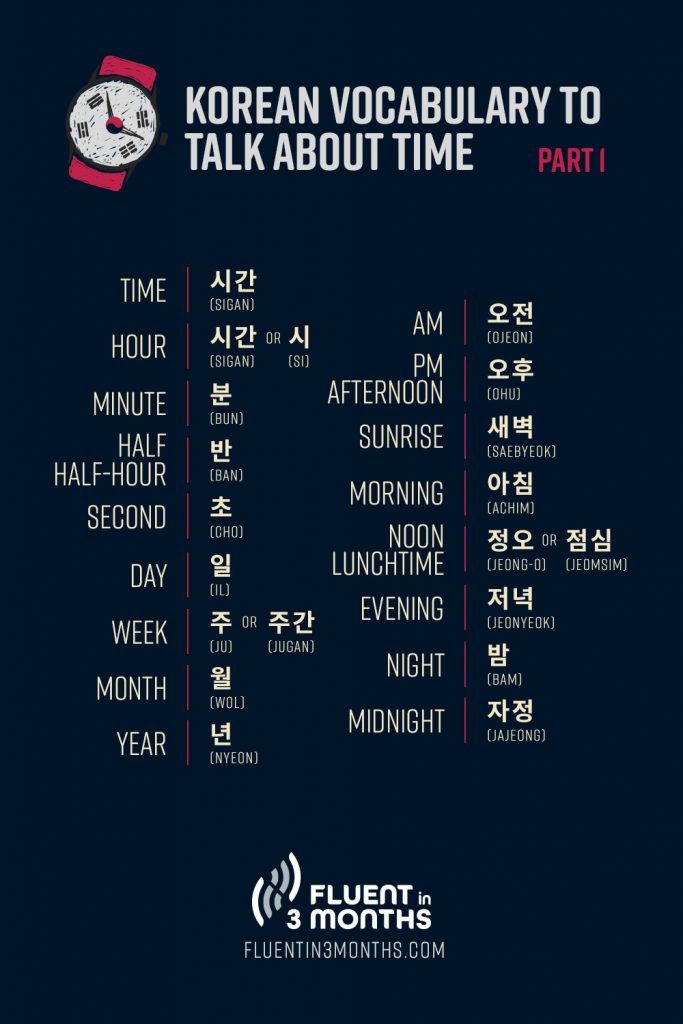How to Tell Time in Korean: Everything You Should Know!
Let’s learn how to tell time in Korean! Everyone needs to know how to talk about time, and Korean time is no different. So I’ll teach you all the basics in this article.
If you’re a beginner, we’ll start with reviewing Korean numbers, and then move on to telling time and dates. Then you’ll learn some important phrases so you can make and stick to appointments and meetups!
If you’re wondering what time it is in Korea compared to where you’re at, Korea uses Korea Standard Time (KST). It’s 9 hours ahead of UTC (Coordinated Universal Time) and 14 hours ahead of EST (Eastern Standard Time).
One other question you may have before we get started: Does Korea use a 12 or 24-hour clock? Like in many parts of the world, the 12-hour clock is most common in Korea. But 24-hour clocks are used in the military and time schedules (like at the airport, for example).
Time’s a wastin’!
Table of contents
How to Say “Time” in Korean
“Time” in Korean is 시간 (sigan). “Hour” in Korean is also 시간 (sigan) or 시 (si). 시간 (sigan) is used for length of time, whereas 시 (si) is used to mark an hour (“o’clock”).
Here are some more Korean time words to know:
- Minute: 분 (bun)
- Half/half-hour: 반 (ban)
- Second: 초 (cho)
- Day: 일 (il)
- Week: 주 (ju) or 주간 (jugan)
- Month: 월 (wol)
- Year: 년 (nyeon)
- AM: 오전 (ojeon)
- PM/Afternoon: 오후 (ohu)
- Sunrise: 새벽 (saebyeok)
- Morning: 아침 (achim)
- Noon/Lunchtime: 정오 (jeong-o) or 점심 (jeomsim)
- Evening: 저녁 (jeonyeok)
- Night: 밤 (bam)
- Midnight: 자정, jajeong

How to Tell Time in Korean: Review Korean Numbers
How to write time in Korean depends on knowing the Korean number systems! Yes, that’s right – systems. Korean has two, the Native Korean numbers and the Sino-Korean numbers.
I explained all this in-depth in our guide to Korean numbers, but here’s a quick review of 1 – 12.
Sino-Korean numbers:
- 1: 일 (il)
- 2: 이 (i)
- 3: 삼 (sam)
- 4: 사 (sa)
- 5: 오 (o)
- 6: 육 (yuk)
- 7: 칠 (chil)
- 8: 팔 (pal)
- 9: 구 (gu)
- 10: 십 (sip)
- 11: 십일 (sibil)
- 12: 십이 (sibi)
And the Native Korean numbers:
- 1: 하나 (hana, but is usually shortened to 한 or han)
- 2: 둘 (dul)
- 3: 셋 (set)
- 4: 넷 (net)
- 5: 다섯 (daseot)
- 6: 여섯 (yeoseot)
- 7: 일곱 (ilgop)
- 8: 여덟 (yeodeol)
- 9: 아홉 (ahop)
- 10: 열 (yeol)
- 11: 열하나 (yeolhana)
- 12: 열둘 (yeoldul)
So here’s where things get a bit tricky at first. You’ll use the Native Korean numbers (hana, dul, set) for hours. And you’ll use the Sino-Korean numbers (il, i, sam) for minutes and seconds, as well as days/weeks/months/years.
Korean Time Grammar: What You Need to Know
Okay, so how do we put all this together?
Let’s start with hours. First, you’ll combine your Native Korean number with the word for hour, 시 (si). Here are some examples:
- 1 o’clock: 한 시 (han si)
- 5 o’clock: 다섯 시 (daseot si)
- 12 o’clock: 열두 시 (yeoldu si – note you drop the final batchim, “l”)
Got the hang of it? Cool. Now let’s try out minutes. This time, we’ll be using the Sino-Korean numbers:
- 10 minutes: 십분 (sip bun)
- 15 minutes: 십오분 (sipo bun)
- 30 minutes: 삼십분 (samsip bun) or 반 (ban, “half”)
- 45 minutes: 사십오분 (sasipo bun)
Remember, we stack the numbers to create what we need. So “40” is “4 + 10” and “15” is “10 + 5”.
Now let’s put it all together:
- 1:10: 한 시 십 분 (hansip sip bun)
- 5:15: 다섯 시 십오 분 (daseot si sipo bun)
- 7:30: 일곱 시 반 (ilgop si ban) or 일곱 시 삼십 분 (ilgopsi samsip bun)
- 12:45: 열두 시 사십오 분 (yeoldu si sasipo bun)
Now for a bit of the grammar. If you want to add “AM” or “PM”, it needs to go before the time, not after. For example:
- 1:10pm: 오후 한 시 십 분 (ohu hansip sip bun)
- 5am: 오전 다섯 시 (ojeon daseot si)
You’ll use the Korean particle 에 (e) if you want to talk about a time when something happens. Like this:
오전 9시에 일하러 가요.<br>
Ojeon ahopsi-e ilhareo gayo.<br>
“I go to work at 9am.”
Talking About Days, Weeks, Months and Years in Korean
Now that we can tell time, let’s talk about bigger units of time: days of the week and dates on a calendar.
The months of the year are:
- January: 일월 (irwol)
- February: 이월 (iwol)
- March: 섬월 (samwol)
- April: 서월 (sawol)
- May: 오월 (owol)
- June: 유월 (yuwol)
- July: 칠월 (chirwol)
- August: 팔월 (parwol)
- September: 구시월 (guwol)
- October: 시월 (siwol)
- November: 십일월 (sibirwol)
- December: 십이월 (sibiwol)
You may notice that the months are just the Sino-Korean number + 월, wol, for months.
The days of the month are the same. They’re the Sino-Korean number + 일, il:
- 1일, ilil: First of the month
- 10일, sibil: Tenth of the month
- 25일, isiboil: Twenty-fifth of the month
For years, you’ll use numbers here as well. “Thousand” in Korean is 천, cheon. And “hundred” is 백, baek.
- 1999: 1999년 in writing, pronounced 천구백구십구년, cheon gubaek gusibgu nyeon
- 2022: 2022년 in writing, pronounced 이천이십이, icheon isibi nyeon
And the days of the week are:
- Monday: 월요일 (wollyoil)
- Tuesday: 화요일 (hwayoil)
- Wednesday: 수요일 (suyoil)
- Thursday: 목요일 (mogyoil)
- Friday: 금요일 (geumyoil)
- Saturday: 토요일 (toyoil)
- Sunday: 일요일 (illyoil)
(By the way, we have a whole guide to days of the week in Korean if you want to learn more!)
When you put it all together, you’ll write the year first, then the month, then the day and day of the week. So it’ll look like this:
오늘은 2022년 5월 4일 화요일이에요.<br>
Oneul-eun icheon isibi nyeon owol sail hwayoil ieyo.<br>
“Today is Tuesday, May 4th, 2022.”
Lastly, here are some helpful time-related vocab for talking about days, weeks, months, and years:
- Today: 오늘, oneul
- Tomorrow: 내일, naeil
- Yesterday: 어제, eoje
- Day after tomorrow: 모레, more
- Two days ago: 이틀 전, iteul jeon
- This week: 이번 주, ibeon ju
- Last week: 지난주, jinanju
- Next week: 다음주, da-eumju
- The week after next: 다 다음주, da da-eumju
- Two weeks ago: 이주 전, iju jeon
- This year: 올해, olhae
- Next year: 내년, naenyeon
- Last year: 작년, jagnyeon
- In two years: 이년 후, inyeon hu
- Two years ago: 이년 전, inyeon jeon
- Now: 지금, jigeum
- Before: 전에, jeon-e
- Later: 나중, najung
- Earlier: 더 일찍, deo iljjik
Time-Related Questions in Korean
You’ve learned how to talk about time and dates now, so now you need to know how to ask about time! These common questions will be good ones to memorize.
“What time is it right now?” in Korean is 지금 몇 시지? (jigeum myeot siji?) or 지금 몇 시예요 (jigeum myeot siyeyo) for more polite situations. For just “What time is it?” in Korean, drop 지금 (jigeum) so it’s just 몇 시예요? (myeot siyeyo)
Here are some other questions you might want to ask:
- “What time shall we meet?” – 몇 시에 만날까요?, myeot si-e mannalkkayo?
- “What time is the concert?” – 콘서트는 몇 시입니까?, konseoteu-neun myeot siimnikka?
- “What time is…” – …몇시입니까?, myeot siimnikka?
- “When?” – 언제, eonje
- “When is it?” – 그게 언제에요?, geuge eonje-eyo?
- “When is your birthday?” – 당신의 생일은 언제입니까?, dangsin-ui saengil-eun eonje imnikka?
- “When do you go to work?” – 언제 일하러 가니?, eonje ilhareo gani?
If you want to know how to say “this whole time” in Korean, you can use 내내 (naenae, “all the time”) or 종일 (jong-il, “all day”). For instance, 내내 일했어요 (naenae ilhaesseoyo), “I worked this whole time.”
Another similar statement you might want to make related to time is “long time no see” in Korean. That’s 오랜만이에요 (oraenmanieyo, formal) or 오랜만이야 (oraenmaniya, informal).
Time to Wrap Up This Korean Lesson
You did it! You learned how to tell time in Korean. Here’s a quick review:
- Hours in Korean use the Native Korean number system.
- Minutes, seconds, dates and months use the Sino-Korean number system.
- “AM” and “PM” come before the time, not after.
- Use 반 (ban) to say “half hour”.
- When saying or writing dates, it goes [year] [month] [date] [day].
- Ask “What time is it?” with 지금 몇 시지? (jigeum myeot siji?)
- “When is it?” is 그게 언제에요? (geuge eonje-eyo?)
Now the most important thing to do is practice! It can be hard to remember the Native-Korean-then-Sino-Korean-Numbers change from hours to minutes – so practice makes perfect.
Practice telling yourself the time. Write the date and time in hangul. The more you practice, the faster you’ll master telling time in Korean!
Ready to learn more? Here are some other Korean guides to level up with:




Social